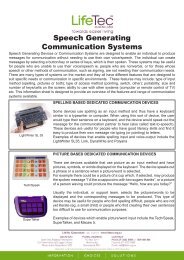Choosing a Lounge or Dining Chair - LifeTec Queensland
Choosing a Lounge or Dining Chair - LifeTec Queensland
Choosing a Lounge or Dining Chair - LifeTec Queensland
Create successful ePaper yourself
Turn your PDF publications into a flip-book with our unique Google optimized e-Paper software.
<strong>Choosing</strong> a <strong>Lounge</strong> <strong>or</strong> <strong>Dining</strong> <strong>Chair</strong><br />
<strong>Choosing</strong> a comf<strong>or</strong>table and functional chair involves careful consideration of personal taste, the<br />
intended use f<strong>or</strong> the chair and the user. The following guidelines and inf<strong>or</strong>mation may help in selecting<br />
a suitable lounge chair <strong>or</strong> dining chair. Occupational Therapists can assist with the selection of the<br />
most appropriate chair f<strong>or</strong> an individual’s needs.<br />
<strong>Lounge</strong> <strong>Chair</strong>s are generally designed to allow a person to relax, <strong>or</strong> to do sedentary activities such as<br />
watching television, reading, <strong>or</strong> engaging in conversation.<br />
<strong>Dining</strong> <strong>Chair</strong>s are designed to make eating, drinking and other tabletop activities such as card playing<br />
and writing easier.<br />
<strong>Chair</strong> with Adjustable<br />
Seat Height<br />
<strong>Chair</strong> with Adjustable<br />
Seat Depth<br />
Adjustable Supp<strong>or</strong>tive<br />
Backrest<br />
FEATURES TO LOOK FOR<br />
Suitable seat height: The person should be able to sit down and stand up<br />
easily. The user’s feet should be supp<strong>or</strong>ted flat on the flo<strong>or</strong>, <strong>or</strong> a footrest<br />
when seated. <strong>Chair</strong> raising blocks raise an existing chair to an appropriate<br />
height. F<strong>or</strong> a dining chair used at a table, the person’s f<strong>or</strong>earms should rest<br />
at about 90 degrees on the table. Some chairs feature height adjustment,<br />
which makes them suitable f<strong>or</strong> several users. Often the table height can<br />
also be adjusted up <strong>or</strong> down to suit.<br />
Firm seat: The seat should be as firm to make rising easier and to supp<strong>or</strong>t<br />
good posture, yet comf<strong>or</strong>table.<br />
Adequate seat depth: The seat should be deep enough to supp<strong>or</strong>t along<br />
the length of the buttocks and thighs, with the front rounded off to avoid<br />
pressure behind the knees. Some chairs also offer adjustable seat depth.<br />
Adequate seat width: The width of the seat should allow about 2.5cm of<br />
space on each side of the thighs.<br />
SUPPORTIVE BACKREST<br />
The backrest should supp<strong>or</strong>t the natural curves in the back. A lounge chair<br />
should also provide supp<strong>or</strong>t f<strong>or</strong> the head and neck.<br />
A leg rest should be used with a reclining seat to raise the legs and avoid<br />
strain on the lower back.
<strong>Chair</strong> with Padded Armrests<br />
<strong>Chair</strong> with<br />
Swing-away Armrests<br />
Footrest<br />
Manual Lift <strong>Chair</strong><br />
Electric Lift & Recline <strong>Chair</strong><br />
ARMRESTS<br />
The armrests should be close to the person’s side to allow comf<strong>or</strong>table<br />
supp<strong>or</strong>t of the f<strong>or</strong>earm and relaxation of the shoulders. The elbows should<br />
rest at about 90 degrees from the body when the shoulders are relaxed.<br />
The armrests assist with sitting down and standing up. They should be long<br />
enough to be level with the front of the seat. This also allows the full length<br />
of the arms and hands to be supp<strong>or</strong>ted.<br />
Padding on the armrests can increase comf<strong>or</strong>t, but should be firm enough<br />
f<strong>or</strong> stability when using them to assist standing.<br />
On a dining chair the armrests should allow the person to sit close to<br />
the table. Some chairs feature adjustable height armrests <strong>or</strong> swing away<br />
armrests.<br />
FOOTRESTS<br />
Personal preference and medical advice often determines the most suitable<br />
style of footrest.<br />
Many brands of chairs offer an optional footrest. Many styles of footrests are<br />
available. Some provide supp<strong>or</strong>t only to the feet, while others will supp<strong>or</strong>t<br />
the feet and the lower legs.<br />
LIFTING CHAIRS / LIFT & RECLINE CHAIRS<br />
These chairs are available in manual <strong>or</strong> electric models and may come<br />
with a reclining backrest. The maximum recommended user weights f<strong>or</strong><br />
each chair vary depending on the brand, so it is best to check this with the<br />
supplier.<br />
The manual lift models help the user with standing. The person must still<br />
move themselves to a standing position, but they are “boosted” by the seat.<br />
Spring tension can be easily adjusted acc<strong>or</strong>ding to the user’s weight and<br />
ability.<br />
The electric lift and recline models raise the person into a standing position<br />
with minimum eff<strong>or</strong>t from the user.<br />
The control switches are located in a hand held unit <strong>or</strong> mounted in the<br />
armrest. These electric chairs plug into standard household power points.<br />
NEED TO KNOW MORE?<br />
Telephone, fax <strong>or</strong> e-mail your enquiry to obtain further inf<strong>or</strong>mation from an occupational therapist<br />
about products. Alternatively, you can call <strong>LifeTec</strong> <strong>Queensland</strong> to make an appointment to see <strong>or</strong> trial<br />
equipment at the our display centre <strong>or</strong> possibly to try equipment through the outreach service.




